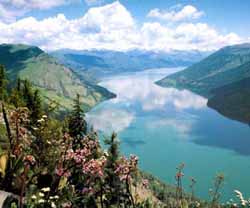
|
CHINA> About Xinjiang
 |
|
Brief Intro To Xinjiang Uygur Autonomous Region
(Xinhua)
Updated: 2009-07-08 13:26 Religion: Xinjiang's diversity is also reflected in the practice of religion, with major religions ranging from Lamaism (Tibetan Buddhism), Islam, Buddhism and Taoism to Christianity, Catholicism, Eastern Orthodox and Shamanism.
 While Xinjiang is famous for the ancient Silk Road, it is also home to 256 ancient cultural sites, tombs, ruins, Buddhist caves, stone sculptures and numerous contemporary monuments, some 154 of the sites are under state protection. In recent years, the region has opened 22 nature reserves for the protection of flora and fauna. The discovery of petroglyphs in Altay and dinosaur fossils has aroused the interests of experts, scholars and tourists alike. While Xinjiang is famous for the ancient Silk Road, it is also home to 256 ancient cultural sites, tombs, ruins, Buddhist caves, stone sculptures and numerous contemporary monuments, some 154 of the sites are under state protection. In recent years, the region has opened 22 nature reserves for the protection of flora and fauna. The discovery of petroglyphs in Altay and dinosaur fossils has aroused the interests of experts, scholars and tourists alike.Xinjiang is not only known as the land of fruits and melons, but also as the home to music and dance. When visiting Turpan one can either watch or join in singing and dancing the "maixilaipu" with friendly Uygurs. While sitting under trellises laden with grapes and enjoying the sweet fragrance of grapes, melons and various other fruits wafting through the air, one is most often entertained by Uygurs singing rousing folk songs to the accompaniment of a three-stringed dotar.
|
|||||